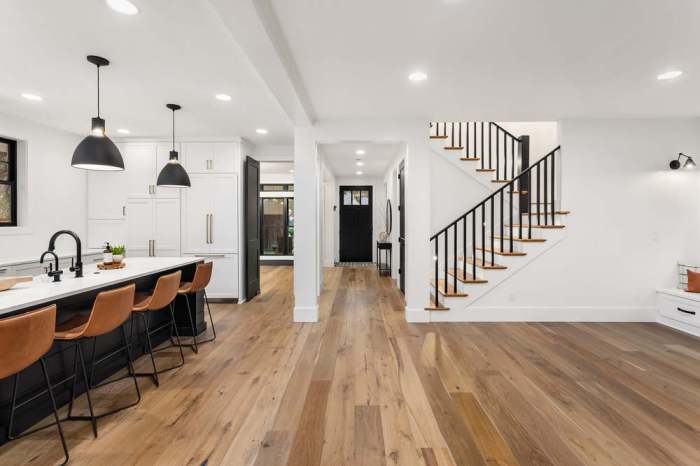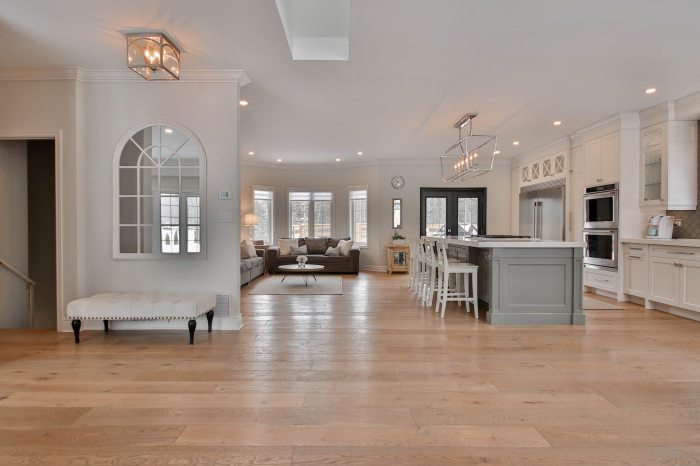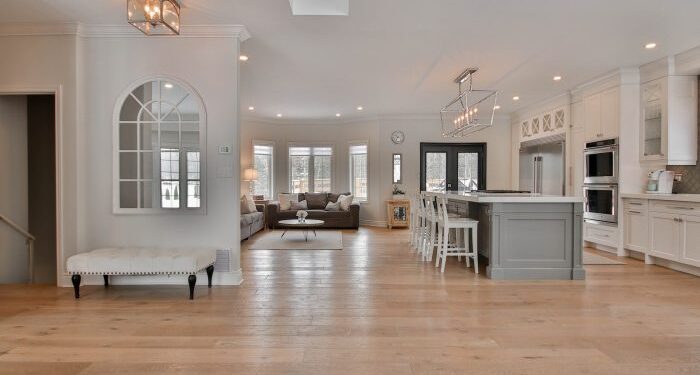Embarking on a home remodel project involves numerous decisions, with one of the most crucial being the choice of flooring. From the warmth of hardwood to the durability of tile, the options are vast and varied. Let's delve into the realm of flooring materials and discover what makes each type unique and suitable for your home remodel needs.
As we explore the different types of flooring materials, their installation methods, and maintenance requirements, you'll gain valuable insights to help you make an informed decision for your home renovation project.
Types of Flooring Materials

When it comes to home remodeling, choosing the right flooring material is crucial as it can significantly impact the overall look and feel of your space. Here are some popular types of flooring materials to consider:
Hardwood Flooring
- Characteristics: Made from natural wood, durable and long-lasting.
- Benefits: Adds warmth and elegance, increases home value.
- Durability: Can last for decades with proper maintenance.
- Maintenance Requirements: Regular cleaning and refinishing every few years.
- Cost: Higher upfront cost, but adds value to the property.
Laminate Flooring
- Characteristics: Synthetic material that mimics the look of hardwood.
- Benefits: Affordable, easy to install, scratch and water-resistant.
- Durability: Less durable than hardwood, but still long-lasting.
- Maintenance Requirements: Easy to clean and maintain.
- Cost: Budget-friendly option compared to hardwood.
Vinyl Flooring
- Characteristics: Made from synthetic materials, available in various styles.
- Benefits: Water-resistant, durable, and comfortable to walk on.
- Durability: Resistant to scratches, stains, and dents.
- Maintenance Requirements: Easy to clean and maintain.
- Cost: Affordable option for those on a budget.
Tile Flooring
- Characteristics: Made from materials like ceramic, porcelain, or natural stone.
- Benefits: Versatile, durable, and available in a wide range of designs.
- Durability: Highly durable and resistant to water damage.
- Maintenance Requirements: Regular cleaning and sealing depending on the type of tile.
- Cost: Cost varies depending on the type of tile chosen.
Carpet Flooring
- Characteristics: Soft and comfortable underfoot, available in various colors and textures.
- Benefits: Provides warmth, sound insulation, and a cozy feel to the room.
- Durability: Less durable than hard surfaces, may require replacement sooner.
- Maintenance Requirements: Regular vacuuming, professional cleaning recommended.
- Cost: Wide range of prices depending on the quality and material.
Considerations for Choosing Flooring
When selecting the best flooring for your home remodel, there are several factors to consider to ensure you make the right choice. Factors such as traffic patterns, lifestyle, and design preferences play a crucial role in determining the most suitable flooring material for each room in your home.
Matching Flooring Materials to Different Rooms
It is essential to match the flooring material to the specific functions and aesthetics of each room in your home. For example, high-traffic areas like the living room and kitchen may require durable flooring options like hardwood or tile, while bedrooms can benefit from the comfort of carpet.
Consider the design style of each room as well to ensure the flooring complements the overall look and feel of the space.
Assessing Subfloor Condition
Before choosing a flooring material, it is important to assess the condition of the existing subfloor. Uneven or damaged subfloors may require additional preparation before installing certain types of flooring. For example, hardwood flooring may not be suitable for a subfloor with moisture issues, while vinyl or laminate flooring can be more forgiving in such situations.
It is crucial to address any subfloor issues to ensure the longevity and performance of your new flooring.
Installation Methods and Techniques

When it comes to installing different types of flooring in your home, there are various methods and techniques to consider. Understanding the installation process is crucial to ensure a successful outcome and long-lasting results.
Floating Installation
In floating floor installation, the planks or tiles are not attached to the subfloor but rather interlock with each other. This method is commonly used for laminate, vinyl, and engineered wood flooring. It is a popular choice for DIY projects as it does not require adhesive or nails.
Nail-Down Installation
Nail-down installation involves securing hardwood planks to the subfloor using nails or staples. This method provides a sturdy and permanent installation, ideal for solid hardwood flooring. Specialized nail guns or staplers are needed for this type of installation.
Glue-Down Installation
Glue-down installation requires applying adhesive to the subfloor before placing the flooring material on top. This method is commonly used for vinyl, cork, and some engineered wood flooring. It provides a strong bond and is recommended for areas with high foot traffic.
Click-Lock Installation
Click-lock installation involves connecting the flooring planks or tiles by snapping them together at the edges. This method is popular for laminate and luxury vinyl flooring. It is a straightforward and efficient installation process, suitable for DIY projects.
Tools and Equipment
For DIY installation, basic tools such as a tape measure, hammer, tapping block, and saw may be required. Professional installation may involve more specialized tools like a flooring nailer, adhesive spreader, and power saw. It is important to use the right tools for each installation method to ensure precision and efficiency.
Common Challenges and Solutions
Some common challenges during flooring installation include uneven subfloors, moisture issues, and matching patterns for a seamless look. To overcome these challenges, it is essential to properly prepare the subfloor, use moisture barriers if needed, and plan the layout carefully.
Seeking professional help for complex installations or challenging conditions is always a good idea to ensure a flawless finish.
Maintenance and Care Tips
Proper maintenance and care are essential to ensure the longevity and aesthetic appeal of your flooring. Different types of flooring require specific cleaning methods and care routines to keep them looking their best.
Hardwood Flooring
- Regularly sweep or vacuum hardwood floors to remove dirt and debris that can scratch the surface.
- Use a slightly damp mop with a hardwood floor cleaner to clean the floors, avoiding excess water to prevent warping.
- Place felt pads under furniture legs to prevent scratches and dents on hardwood floors.
- Avoid using harsh chemicals or abrasive cleaners that can damage the finish of the wood.
Laminate Flooring
- Sweep or vacuum laminate floors regularly to prevent dirt and dust buildup that can scratch the surface.
- Use a damp mop with a laminate floor cleaner to clean the floors, ensuring not to oversaturate the planks.
- Avoid using wax-based cleaners or steam mops on laminate flooring, as they can cause damage.
- Immediately wipe up spills to prevent staining or warping of the laminate planks.
Tile Flooring
- Sweep or vacuum tile floors to remove dirt and debris, focusing on grout lines where dirt tends to accumulate.
- Use a mild detergent or tile cleaner with a soft brush or mop to clean tile floors, paying attention to grout cleaning to prevent discoloration.
- Seal grout lines regularly to protect them from stains and moisture penetration.
- Avoid using harsh acidic cleaners on tile floors, as they can damage the grout and tile surfaces.
Vinyl Flooring
- Sweep or vacuum vinyl floors regularly to remove dirt, dust, and debris that can scratch the surface.
- Clean vinyl floors with a damp mop using a vinyl floor cleaner or a mixture of water and mild soap.
- Avoid using abrasive scrubbers or harsh chemicals that can damage the vinyl surface.
- Place doormats at entryways to prevent dirt and grit from being tracked onto the vinyl floors.
Final Thoughts
In conclusion, selecting the best flooring for your home remodel is a multifaceted process that involves considering factors like durability, aesthetics, and maintenance. By understanding the nuances of various flooring options, you can transform your living space into a stylish and functional haven.
Question Bank
Which flooring material is best for high-traffic areas?
Hardwood and laminate are excellent choices for areas with high foot traffic due to their durability and easy maintenance.
Can vinyl flooring be installed in wet areas like bathrooms?
Yes, vinyl flooring is water-resistant and an ideal option for bathrooms and kitchens.
How can I protect my hardwood floors from scratches?
Use felt pads on furniture legs, area rugs in high-traffic zones, and avoid wearing high heels indoors to prevent scratches on hardwood floors.
What is the average lifespan of carpet flooring?
The longevity of carpet flooring varies depending on the quality and maintenance, but on average, it can last around 5-15 years.






